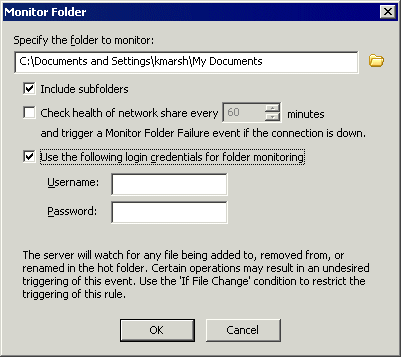Monitoring Folders
(Available in EFT Server Enterprise) Use a Folder Monitor rule to trigger when files are added to a folder using the network file system. When monitoring folders for files added to EFT Server via the FTP/S and HTTP/S protocols, use File Uploaded, File Downloaded, and other File System events.
EFT Server keeps track of the number of active threads over time and periodically calculates the average of number of concurrent active threads over that time period. The sample rate is once every 5 seconds, and the sample period is 10 samples. After sampling 10 times and finding the average concurrent active threads over that period, the system can grow the pool of the concurrent active threads, up to a set maximum number of threads. This means that if EFT Server is currently running close to or above the prior average of concurrent threads, it will grow the thread pool to allow for room for more events. By default, EFT Server starts with 3 threads in the pool per Site, and can grow to a maximum of 32 threads.
In version 6.2, EFT Server will only reset affected (modified) folders when applying configuration changes to an Event Rule, rather than resetting all folders.
|

|
When monitoring a folder, EFT Server watches for any file being added to, removed from, or renamed in the monitored folder. Moving a file, performing PGP operations, and other actions can trigger the Rule again, resulting in failures. This can be avoided by selecting the Stop processing this rule check box after if action failed then.
|
To configure a Folder Monitor rule
-
Follow the procedures in Defining Event Rules.
-
In the Create New Rule dialog box, click Folder Monitor, then click OK. The new Rule appears in the Rule Builder.

-
The If File Change Condition is added automatically to restrict the triggering of the Rule. Click the links in the Condition to specify whether the Rule should trigger when a file in the folder in renamed, added, or removed.
-
In the Monitor folder Event, click [select]. The Monitor Folder dialog box appears. (File browse operations are disabled when you are connected remotely. When you create a Monitor Folder Event Rule remotely, you can't click the folder icon and browse to the path of the file that you want to execute or the folder that you want to monitor on the EFT Server computer. You can, however, type a path that is relevant to the EFT Server computer, not the remote interface).
-

-
Click the folder icon  to specify a folder to monitor.
to specify a folder to monitor.
|

|
To monitor a folder on a remote, non-EFT Server FTP server, supply the full UNC path to the network share. (The format for a UNC path is \\server\volume\directory\file and is not case-sensitive. For example: \\Shared1_svr\Shared1\WGroups\Network\Orders.xls). Make sure that the EFT Server service has sufficient privileges to perform READ operations on the remote share. If you are using the "health check" feature, it must also have WRITE permissions. This is generally easiest if you set the EFT Server service to run as a domain account, or specify a dedicated “run as” account in the Monitor Folder dialog box.
|
-
If you also want to monitor subfolders, select the Include subfolders check box. (For example, if you are monitoring a user folder and the user has created subfolders, unless you select the Include subfolders check box, files added to or changed in subfolders do not trigger the rule.)
-
To monitor the status of the network connection and report failures, select the Check health of network share every <n> minutes check box, and specify an interval. An hour (60 minutes) is specified by default. When you select the check box, the following message appears:

When the check box is selected, EFT Server periodically pings the folder specified to verify that it can communicate with the folder. When there is a loss of connection, EFT Server attempts to re-establish a link to the folder and triggers the Folder Monitor Failed event internally. If you want to receive e-mail failure notifications (or other Actions) when the Folder Monitor health check returns a connection failure, create an additional Event Rule using the Folder Monitor Failure Event, and add the Send notification e-mail Action to it.
|

|
In EFT Server 6.2.29 and later, the time EFT Server waits for the notification from Windows when a Folder Monitor health check file is created can be controlled by a registry value. The default is 20 seconds. EFT Server creates a temporary file in the monitored folder. If Windows does not respond with a FILE CREATED notification within the timeout period, the folder monitor will be stopped and restarted. Some customer logs show these notifications arriving 21 or 22 seconds after the file was created, which is outside the default of 20 seconds, and this causes the folder monitor to be restarted. (It is not necessary to restart the Server service to update the value.) The following registry value can be created to specify a longer timeout:
32-bit: HKEY_LOCAL_MACHINE\Software\GlobalSCAPE Inc.\EFT Server 4.0\Config\
64-bit: HKEY_LOCAL_MACHINE\Software\WOW6432Node\GlobalSCAPE Inc.\EFT Server 4.0\Config\
DWORD "FolderMonitorHealthCheckTimeout" - number of seconds
|
-
To specify login credentials for remote folder monitoring, select the Use the following login credentials for folder monitoring check box, then specify a Username and Password.
-
Click OK.
-
(Optional) Specify an Action/Conditions to occur when this Event is triggered:
-
Click Apply to save the changes on EFT Server.
![]()

